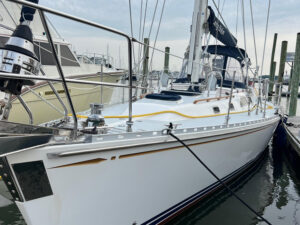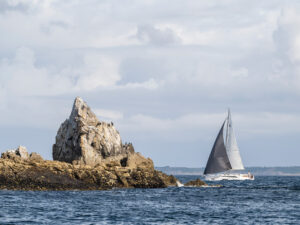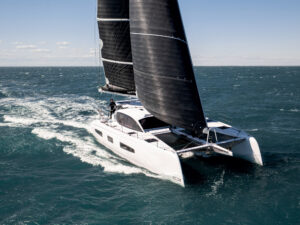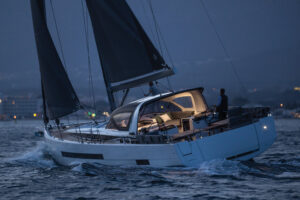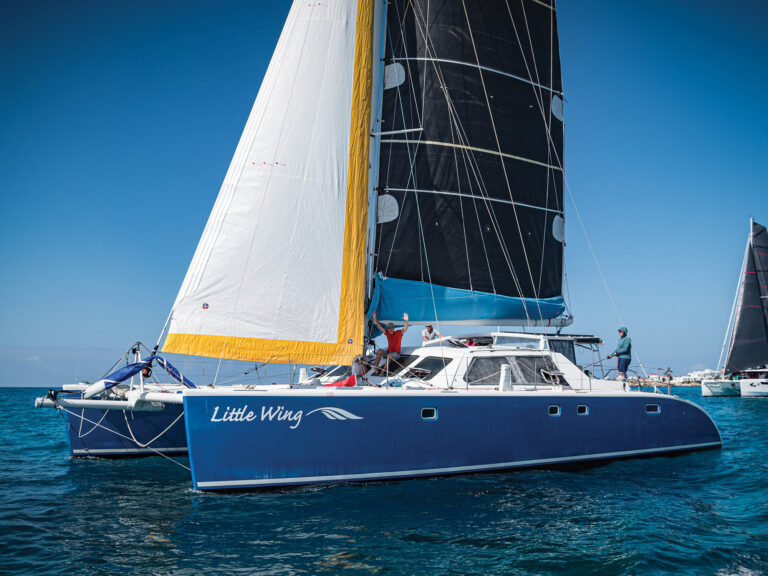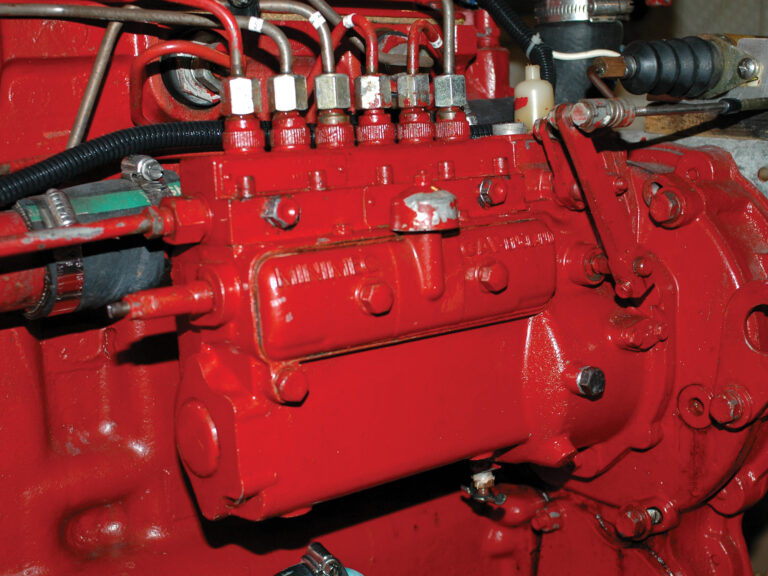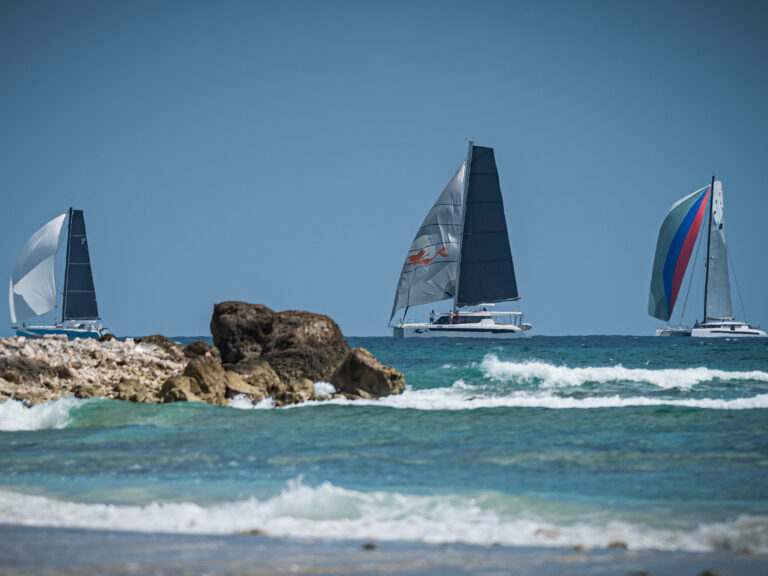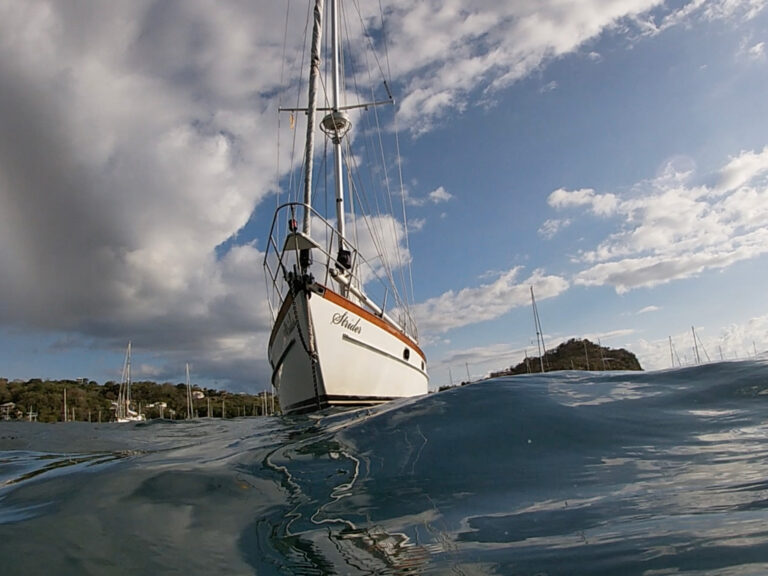This year has a special significance for both Cruising World and myself as it marks the 50th anniversary of both the launch of the magazine and my first boat, way back in 1974. In the years since, Cruising World has become the go-to information source for sailors planning extended voyages, many of them also referencing my books: World Cruising Routes, World Voyage Planner and World Cruising Destinations, which are the result of my own voyages on five successive Aventuras through those 50 years.
When I was asked by Cruising World to report on this year’s International Multihull Show, held at La Grande Motte, France, I was struck by the irony of our parallel paths once again crossing, and I jumped at the opportunity. Having a reason to return to the town where my last boat, Aventura Zero, a bespoke version of the Outremer 45, was built.
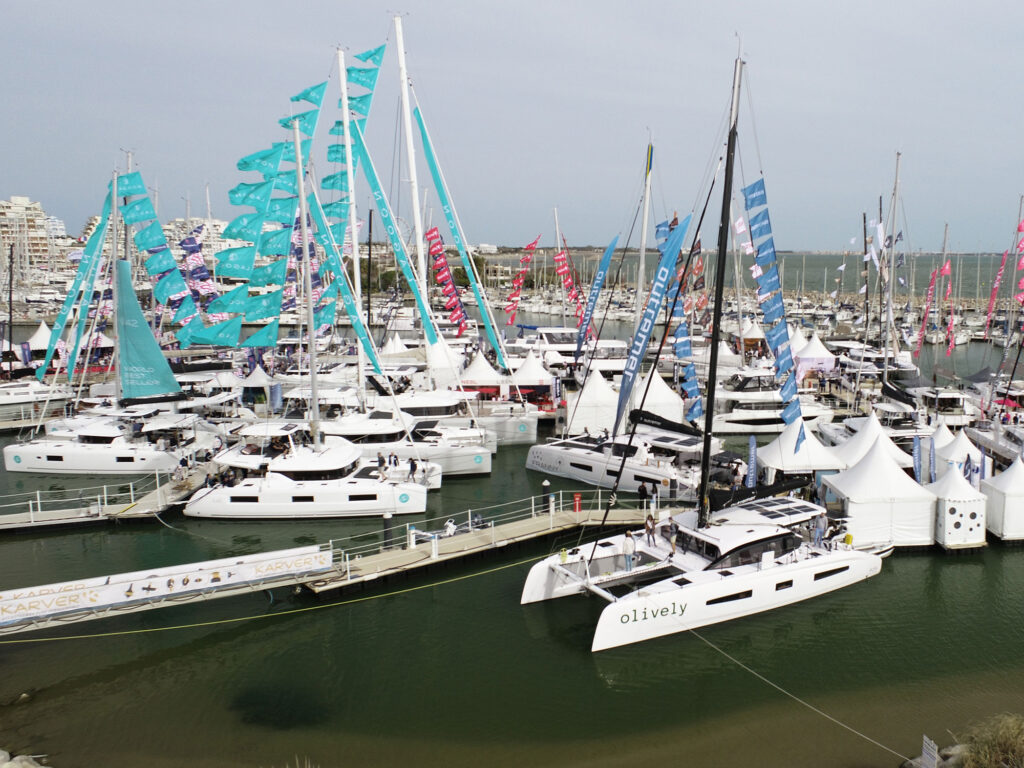
More than 70 multihulls were on display in the attractive, Mediterranean port, from a Tricat 30 to a GP70 catamaran. All the major players were there, providing a modern glimpse at how multihulls have evolved over the years. We know that their popularity among cruising sailors has been steadily increasing, as shown by recent figures I gathered from Cape Town, a key transit point on the world cruising circuit. Among the 169 sailing boats that passed through in 2023, 56 (or 33 percent) were catamarans. A similar increase was reported in the ARC transatlantic rally in 2023 where, among the fleet of 252 boats, 71 (28 percent) were catamarans.
My first boat should have been a catamaran, which I believed would have been best suited for the voyage I was planning with Gwenda and our two young children, Doina and Ivan. In the early ’70s, Britain was the world leader in catamaran construction, and the Prout Snowgoose 35 would have been my choice. The problem was that we only had enough money to buy the bare hulls, as I was planning to handle the rest myself. When I approached the builders, they firmly refused, so I ended up with a 36-foot Trintella GRP hull designed by the Dutch naval architect Van de Stadt and built by Tyler Boat Co. near London. Working every free minute away from my job as a BBC radio reporter, I managed to finish fitting out the ketch-rigged hull in just over one year. The first Aventura was launched in July 1974.
Remembering those days of chasing that elusive Snowgoose, I was pleased to see that, among the boats on display at the show, there were four catamarans of a similar size: the Aventura 37, the Excess 11, the Comar-Cat 37 and the Bali Catsmart. These represented the smallest cruising catamarans at the show. I marvelled at how, even in a relatively small LOA, the designers of each of these cats managed to fit both a spacious living area and a functional cockpit, as well as three or four separate cabins. After visiting their larger peers, I was just as surprised by their prices ($360,000 for the Aventura 37, $380,000 for the Bali Catsmart, $400,000 for the Comar-Cat 37, and $480,000 for the Excess 11). In the context of a new-boat show where the majority of boats cost north of $1 million, price is relative—but is it affordable?
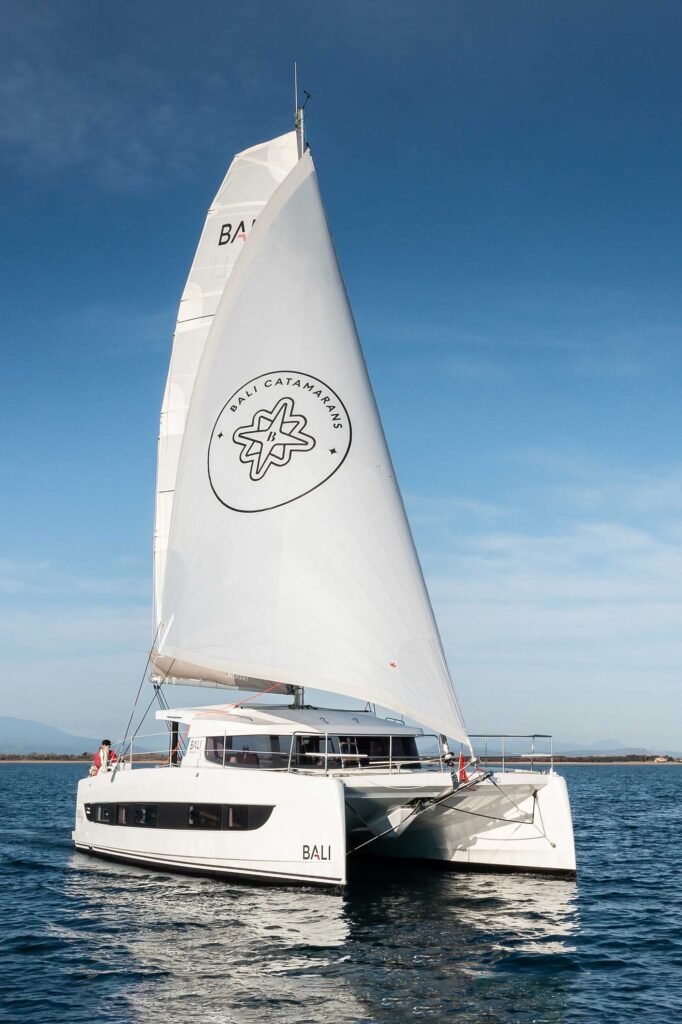
In recent years, the price of boats has been steadily increasing, well above the rate of inflation. The cost of materials and labor obviously play a part in this, but I suspect that high demand is also a determining factor. For comparison, I looked back at the cost of a similar boat 50 years ago, when a boat of that size would have cost $30,000 and the average annual salary in the US was $12,000 (whereas it is currently $64,000). In 1974, a similar boat would have cost the equivalent of 2.5 years of earnings, whereas now it is more than five years.
Earlier this year, I concluded a survey on the global movement of cruising boats. With cruising restrictions having been lifted post-pandemic, figures obtained from various transit points around the world showed a return to the prior numbers. At the show, builders reported unprecedented high demand, with a growing number of sailors planning voyages in the near future. Regretfully, I am no longer in that situation, but, based on my own experience, I spent my remaining time at the show determining which boats I might consider today if I was in fact planning another world voyage.
As my requirements have not changed since I prepared Aventura Zero for a world voyage, I would still be keen to do it on a boat with zero emissions, or at least one that could be made as eco-friendly as possible. Several builders were offering the option of electric propulsion, but only Outremer’s 4.zero model could be described as a fully electric boat. All others were employing a variation with a hybrid setup. Four of the boats were catamarans: the ORC 57, the Fountaine-Pajot Aura 51, the Windelo 54 and the HH 44. Two were trimarans: the Neel 34 and the Neel 37. Their builders explained that a fully electric solution was not yet sustainable, so they were addressing this aspect at least halfway for now. The consensus is that it is better to have a hybrid system, reducing carbon emissions by 50 percent or more, than to not address it at all.
For some companies, electrification is not yet on the table, and understandably so. One builder, for instance, noting that its primary customers are either charter operators or individuals investing in charter boats, acknowledged that its hesitation in exploring electric is related to quality control. The fact is, maintaining boats in perfect working order throughout a charter season via a local workforce is much simpler on a standard diesel engine as opposed to a more complex electric setup. Not to mention having to pay an additional nearly 10 to 20 percent for an electrical hybrid system. (Outremer encountered a similar financial reaction from clients interested in the electric propulsion option pioneered by Aventura Zero, instead opting for a hybrid solution. These practical considerations were similarly expressed by representatives of several other leading manufacturers.
Among the various hybrid systems, the all-carbon-fiber HH44 catamaran featured the most ingenious solution, based on its EcoDrive parallel hybrid system. Besides the standard diesel-engine mode, the system operates in three electric modes. In generator mode, with the propeller shaft clutch disengaged, the turning shaft converts the two diesel engines into two 5 kW generators. In silent mode, the disengaged electric motors provide 10 kW of propulsion power per shaft. While sailing in hydro-generation mode, the free-spinning propellers turn the shafts, allowing the electric motors to generate electricity. In addition, the extended coachroof featured an impressive array of solar panels with a total capacity of 4.2 kW.
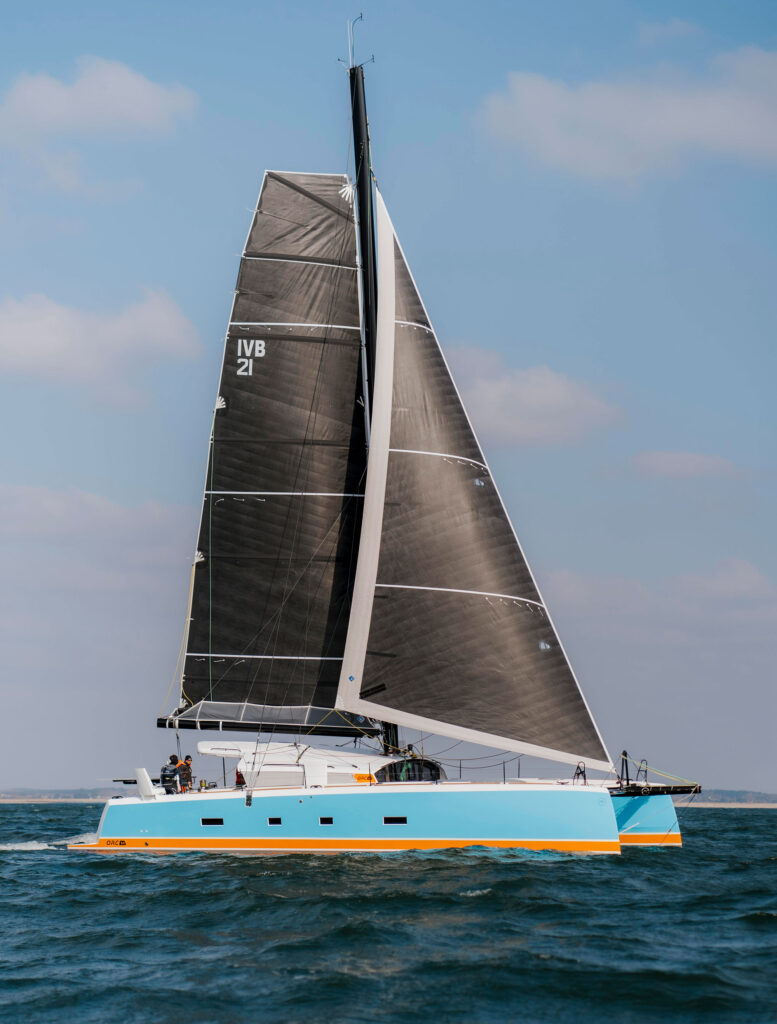
The ORC 57 (Ocean Racing Catamaran) was exhibited by Marsaudon Composites, which has a long history of high-performance racing catamarans and trimarans. Its system consists of two Bellmarine 20 kW electric motors, supplied by a battery bank of 1120 Ah, a genset and 5.8 kW solar panels. The ORC concept is based on three basic principles: performance, simplicity and lightness. All three were evident on this pure racing machine with a displacement of just under 12 tons. I was particularly impressed with a sensor at the base of the synthetic cap shroud, which activates an alarm when the tension exceeds critical mass, warning the crew to reduce sail.
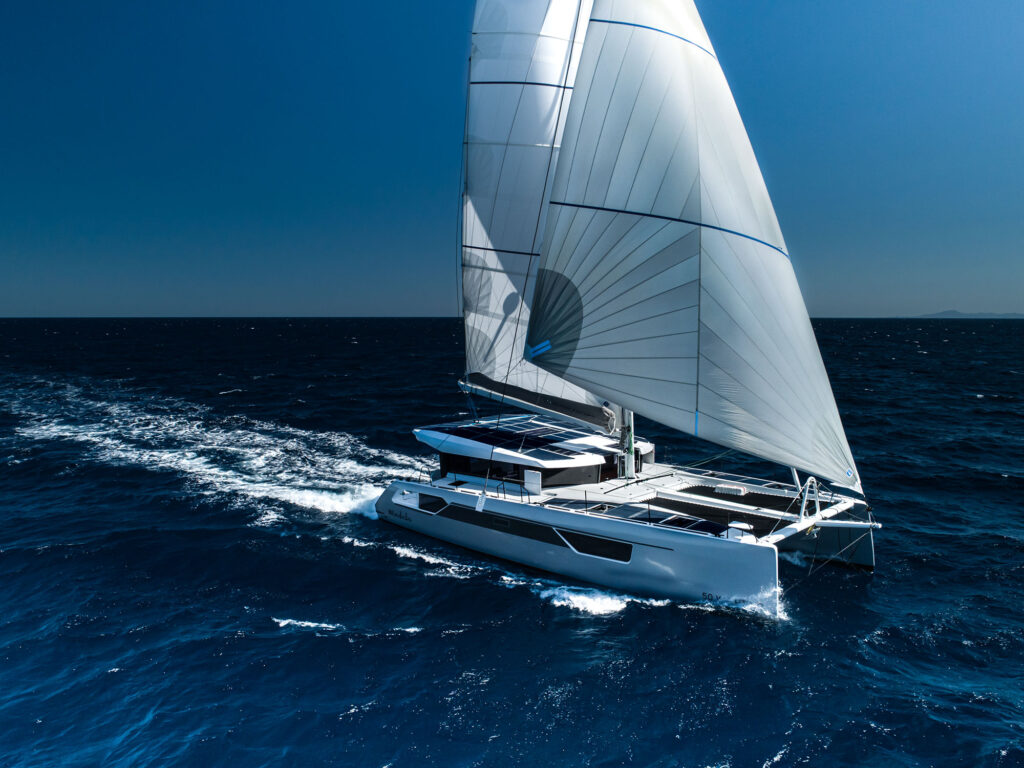
A similar hybrid arrangement is at the heart of the new Windelo 54, another performance-cruising catamaran. According to the builder, its goal is to reduce the carbon footprint within the production process by 50 percent. By using natural basalt fiber and foam from recycled plastic bottles in its construction, that goal was achieved.
Environmental consciousness was also underscored by Thomas Gailly, director of Lagoon catamarans, who said: “With over 7,000 catamarans built in the last 40 years, our main focus is on the ecological aspect. We have replaced synthetic fibers in the hulls by using hemp and other natural materials. All of our boats are now built to ISO 14001 standard that sets out the requirements for an environmental management system. As a result, the carbon footprint is not only drastically reduced in the construction process, but also when the time comes to recycle the hulls at the end of their lives.”
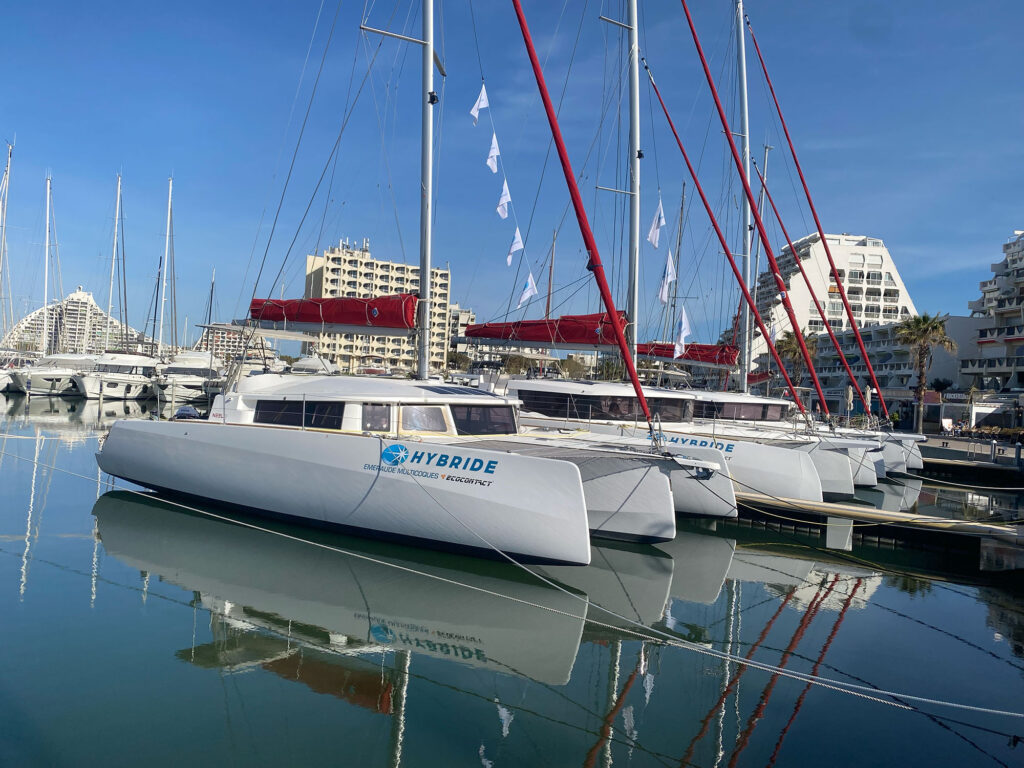
The two Neel trimarans were equipped (not standard) with 25 kW electric motors on a saildrive fitted with a Gori folding propeller. Additional electricity was provided by a 28 kW genset. An enhanced system based on a Bellmarine electric motor is under development and will be an option in 2025, according to the builder.
While all the above examples involve some sort of hybrid system, Balance Catamarans has taken an entirely different approach, equipping its boats with high-output Integrel alternators. The two Yanmar 30 hp engines on the Balance 442 in the show were equipped as such.
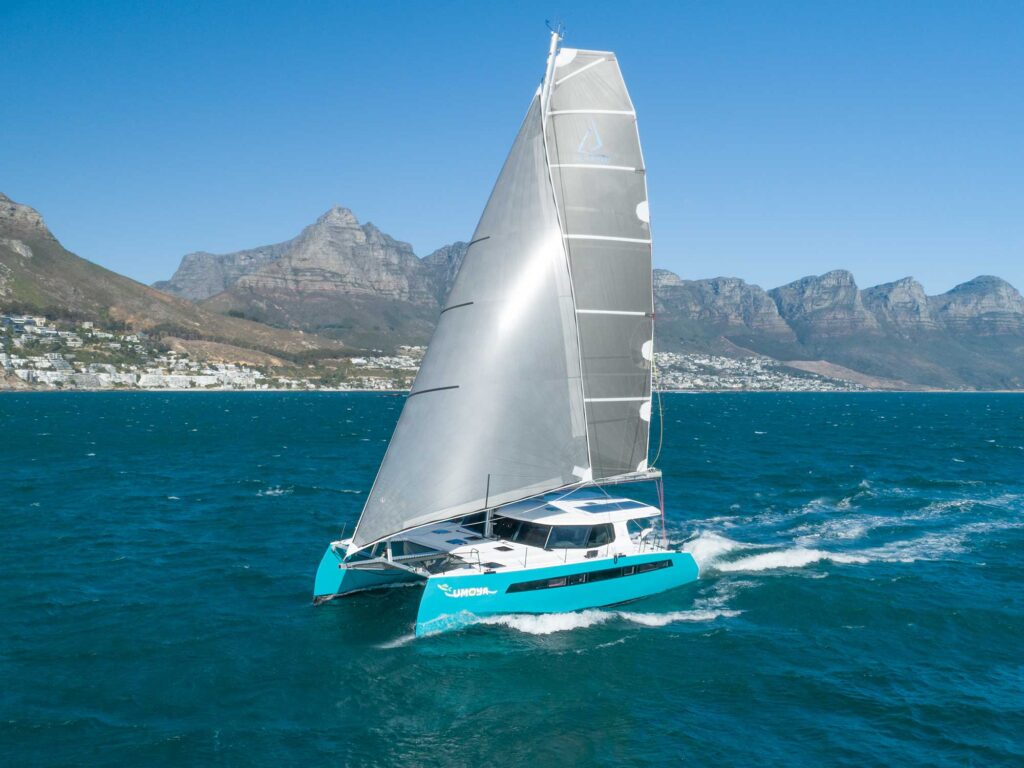
“Thanks to the high-efficiency Integrel alternators, we no longer offer generators on our 442, 482 and 526 models,” said Balance President Phil Berman. “For those who don’t want a hybrid, the Integrel alternators are the greenest and most efficient method of charging 48-volt lithium banks. The next step is the Integrel E-Drive hybrid system, of which the first will be installed later this year.”
Fountaine-Pajot, who has been at the forefront of the movement to renewable sources of energy, has worked with the French company Alternative Energies in the development of hydrogeneration pods and energy storage systems. Its Aura 51 was the first to use the Smart Electric system consisting of a large array of solar panels delivering 2 kW to two battery banks of 32 kWh each. This is supplemented by up to 1.5 kW of electricity generated by the propellers’ reverse rotation when under sail. This efficient yet simple hybrid system is considered to be reliable enough to be offered in the charter option.
According to a Fountaine-Pajot representative, the brand aims to have 50 percent of its catamarans fully electric by 2025. By 2030, it envisions that 100 percent of their fleet will be entirely self-sufficient, with diesel engines completely phased out. If such ambitious objective is eventually echoed by more leading builders, the outlook for multihull boatbuilding indeed feels electric, and in more ways than one.
Visit cornellsailing.com for information on Jimmy Cornell and about his books.

